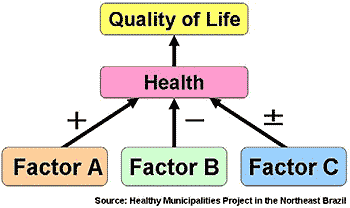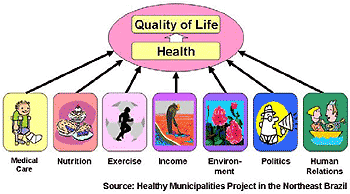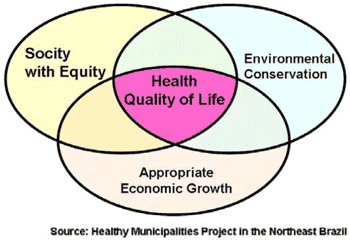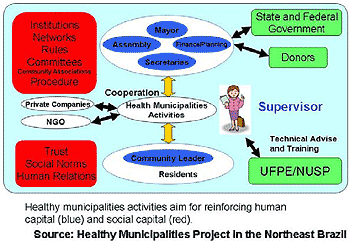Fundamental Concepts of the Project
Health Promotion
 Figure1 : Health Promotion and Health Protection
Figure1 : Health Promotion and Health Protection
Health Promotion basically means inducing influential factors that contribute to health in such a way as to improve health, that is, promoting or increasing Factor A and Factor C that have positive influences over health, as shown in Figure 1. There is also a concept known as Health Protection. This means attempting to exclude limiting factors in health either : eliminating Factor B, which has a totally negative influence over health or weakens negative aspects of Factor C. Measures for pathogens in infectious diseases and risk factors in cardiovascular disease are based on the concept of Health Protection.
Health Promotion began its presence in health strategy when the Ottawa Charter was accepted at the International Conference on Health Promotion held in Ottawa, Canada by the WHO in 1986. Health Promotion has been a major Public Health strategy in the world.
The definition supplied by the WHO is "Health promotion is the process of enabling people to increase control over, and to improve, their health and its determining factors by themselves".
Healthy Municipalities/Cities
 Figure2 : Determinants of Health
Figure2 : Determinants of Health
"Healthy Municipalities" is a Health Promotion strategy, concretized policy or movement started in 34 cities in Europe in 1988 and diffused in 5 cities in developing countries by the WHO in 1995. Since then, it has been widely implemented in a number of developed and developing countries. In Japan, there are activities bearing the name "Healthy Culture Cities" or "Healthy City (Town, Village) Development - Kenko na Machi Dsukuri", and some of these cities collaborate with this project as training institutes for our Brazilian counterparts (e.g. Miyakonojo, Miyazaki and Shiroi, Chiba).
As shown in Figure 2, there are a large number of factors that influence health and quality of life. For this reason, we have to address not only the enhancement of health and medical services, but also the social and environmental factors in daily life. "Healthy Municipalities" is based on these comprehensive views of health and take approaches toward making improvements with community- and municipality-wide interventions addressing various factors. The most important aspect here is the participation of the residents themselves and coordination of government policies from various sectors beyond healthcare.
Sustainable Development
 Figure3 : Healthy Munisipalities and sustainable Development
Figure3 : Healthy Munisipalities and sustainable Development
How can we achieve a balance between limited resources or natural environment and worldwide economic development? This is one of the biggest assignments given to mankind."Sustainable Development", as defined by the UN's Brundtland Commission in 1987 as "development that meets the needs of the present without compromising the ability of future generations to meet their own needs" is currently of global interest. The basic idea of this development strategy is to promote development with the harmonization of the following three factors: social justice, environmental conservation and economic efficiency. Development without social justice increases inequity, without environmental conservation destroys environment, and without economic growth there is no realistic development strategy. Healthy Municipalities treats health and quality of life as common targets of these three factors, as displayed in Figure 3. Health and life are of common interest to all, regardless of age, gender, race, religion or other factors. Thus, Healthy Municipalities lead to a just society by pursuing welfare of all.
Moreover, we must give great consideration to a healthy natural environment. Therefore, Healthy Municipality activities also involve environmental conservation. Although, as with education, it takes time to bear fruit, investing resources in health is known as a solid cornerstone for development. Healthy Municipalities offer bases for appropriate economic growth in the future. As shown above, the Healthy Municipalities Project is a strategy for sustainable development through the balance of these three factors.
Social Capital
 Figure4 : Development of Human Capital and Social Capital
Figure4 : Development of Human Capital and Social Capital
Development of Healthy Municipalities, as set out above, means creation of places of everyday life where priority is given to health and quality of life through the joint action of people.
How does this kind of joint action for accomplishing shared objectives take place? It has recently become clear that the joint action of people is likely to be stimulated more in communities with the accumulation of social factors such as trust, conviviality, norms of reciprocity and network/system/procedure of community participation. On the whole, these social factors of relationships between people are known as "Social Capital".
In 1916, Social Capital was described in the literature for the first time. However, it was only after political scientist Robert Putnam explained the differences of the performance of public services between the central region in Italy and southern and northern regions due to accumulation of social capital such as trust, norms of reciprocity and network of community participation in 1993 that social capital gained recognition in social science. Since then, social capital has been attracting attention in the field of cooperation as a crucial factor that determines the feasibility of projects in development cooperation with developing countries.
In Healthy Municipalities, which promotes joint actions in the community, we positively adopt the concept of social capital along with the concept of human capital, such as capability and skill obtained through the empowerment of the people, in order to generate factors for joint actions and observe this process, as shown in Figure 4. Our Healthy Municipalities project implemented a preliminary survey on social capital in 5 pilot municipalities, adapting the SOCAT (Social Capital Assessment Tool) developed by a World Bank task force.
- About JICA
- News & Features
- Countries & Regions
- Our Work
- Thematic Issues
- Types of Assistance
- Partnerships with Other Development Partners
- Climate Change / Environmental and Social Considerations
- Evaluations
- Compliance and Anti-corruption
- Science and Technology Cooperation on Global Issues
- Research
- JICA Development Studies Program / JICA Chair
- Support for the Acceptance of Foreign HRs / Multicultural and Inclusive Community
- Publications
- Investor Relations
